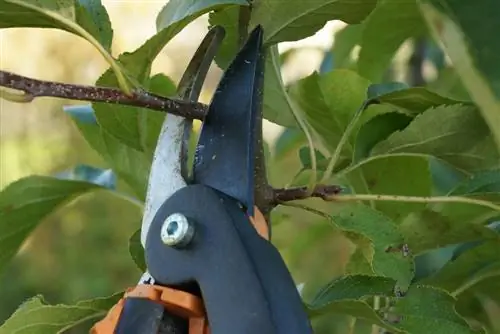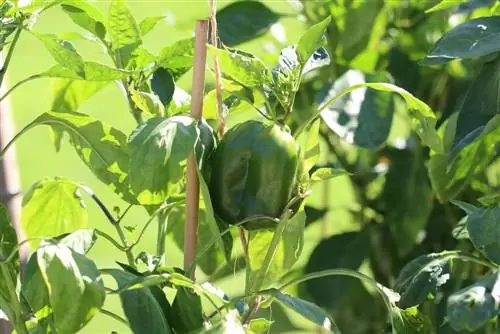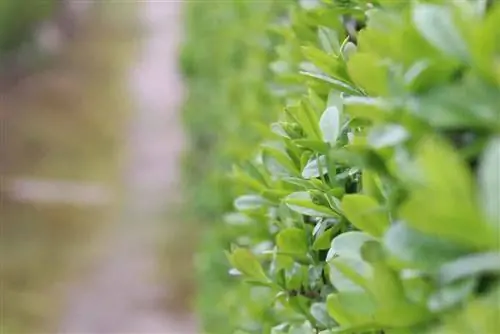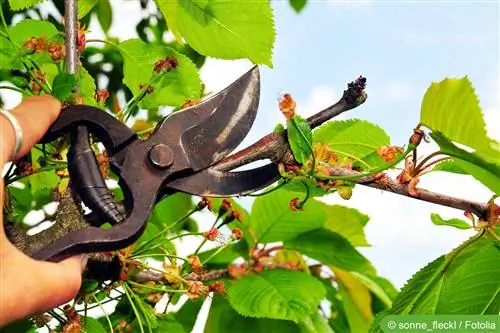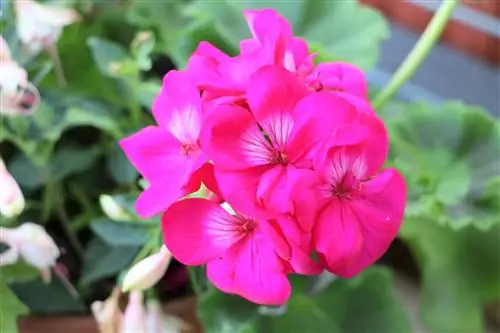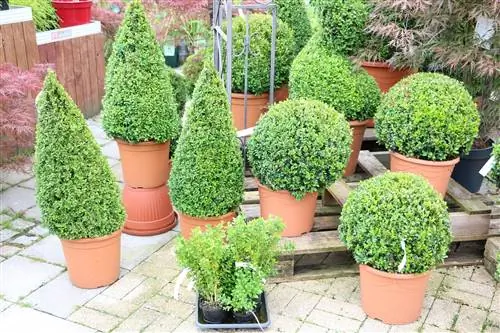- Author admin [email protected].
- Public 2023-12-17 03:39.
- Last modified 2025-06-01 06:48.
Pruning is always a cause for headaches and is also the basis for numerous heated discussions. Always radical - some say and justify this by saying that the tree, shrub or bush will grow back again. Others prefer a more cautious approach so as not to unnecessarily stress or weaken the plants. Even experienced and professional gardeners do not always agree on where each cut should be made. No matter how many different opinions there are, some basic rules are always valid.
Always individual
One tree grows even stronger and more beautiful without any problems if it is radically pruned. The other tree recovers only with difficulty - or never again - from such interventions. The absolute majority of coniferous trees, for example, never sprout again from old wood. If you use the scissors or saw incorrectly, you will permanently change the shape. The result, surprisingly to many hobby gardeners, is a holey tree that will need to be removed or replaced sooner rather than later. But it's not just the appearance that can be disturbed. In the case of fruit-bearing trees, incorrect cutting will at best result in a short-term reduction in flowering or yield. At worst, forever. This is particularly annoying if it is an expensive or already very large plant. A lot of care effort, time and money can be wasted with just a few cuts.
Before you ever use the scissors, it is important to know the special features of the respective plant species. General statements and instructions are only possible to a limited extent because there are too many exceptions to the rules.
Tip:
What was the trimming for the cherry again and what's the name of that tree over there? In order to only have to do the research once, all trees and their special features and requirements should be noted in a garden sketch.
Necessity
Some trees work without any problems or even better without cuttings. Only then can they take on their natural shape and develop their full flower splendor. Here too, cutting may be necessary, for example because there is not enough space in the garden. In principle, before any drastic measures are taken, it should be checked whether offcuts are even necessary. Possible and common reasons are:
- Infestation by diseases or pests
- Woods become too big for the existing area
- Ageing of the plant, cuttings are made for rejuvenation
- Danger of branches breaking off due to wind or snow
- Fruits do not ripen sufficiently
- artificially created form is sought
Under no circumstances should the cutting only be done because the neighbor on the left in the garden wants to help with good advice and thinks the tree needs to be trimmed. Unless the tree in question protrudes far over the garden fence. If you want to be on the safe side, always inform yourself about the special features and requirements of the respective plant or consult a specialist.
Care and preservation
Maintenance or care pruning is probably the most common procedure for woody plants. Thinning can also be classified here. The following will be removed:
- inwardly growing shoots
- crossing branches
- damaged plant parts that are broken, burned, dried up or deformed by diseases and pests
- weak, weak and very thin shoots
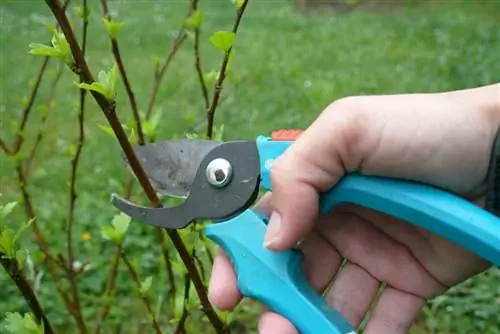
Depending on the type of tree, pruning can be done throughout the season or should only be done in a small time window.
The purpose is to give the tree a lighter crown. On the one hand, this makes it less susceptible to breakage, and on the other hand, fruits can ripen faster and more evenly.
Rejuvenation
The rejuvenation cut occurs when the plant ages. The aging is usually evident from the fact that the tree bears fewer and fewer leaves, flowers and fruits. It generally loses its growth potential and becomes bald. However, these signs can also indicate an incorrect location or a lack of nutrients. The crucial factor here is time. If the tree has thrived so far without any problems, but has already been on the branches for a few years, it is much more likely to become old. The procedure is as follows:
- First, so-called leading shoots are selected. Strong branches and twigs that support numerous small shoots are suitable.
- Using these as a basic framework, the tree is freed from competing shoots in the second step. These are twigs and branches that are almost as thick, but experience shows that they only bear a few leaves and fruits.
- Trees are cut almost down to the trunk, bushes and shrubs are cut close to the ground.
- Plant parts growing inwards, overlapping branches and smaller shoots are also removed.
- The plant or treetop should then appear thinned and trimmed to its extent.
Tip:
For some plants, rejuvenation pruning consists of radically cutting back all shoots close to the ground. Research here is again worthwhile.
pruning
Pruning the tree serves to limit the size. To do this, cut all around, a quarter to a third of the respective shoot length. If you only have a little space available, you should keep trees small right from the start so that the interventions don't become too radical.
Forming
The best example of striking shapes is the Bux tree. Sphere, cone, pyramid - the artificial formation takes place in several steps and must be maintained through regular interventions. This also applies to hedges. First, a rough cutting is made, which creates the basis. This is followed by further fine cuts and compactions. The rough cut is radical, everything else is just a gentle intervention in which new shoots are trimmed to compact them. Then we cut all around so that the circumference can increase but the shape is still maintained.
Tip:
Use templates or stretched cords and other aids for shaping. Cutting by eye usually backfires.
Time
Cherries are cut after the harvest, early-flowering ornamental trees after flowering, most fruit trees during the winter and conifers when the shoots have reached a certain length - so the right time for cutting can vary greatly. In general, the following information applies:
- do not cut in full sun
- Do not cut when it is frosty
- choose overcast days
- avoid high humidity and rain
Again, you have to find out when which tree is optimally cut.
Cutting tools
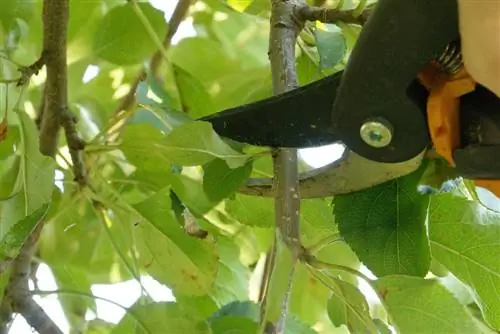
Whether scissors, knives or saws - all cutting tools must be clean and sharp. It is optimal to disinfect the blades between use on each plant.
Wound closure and aftercare
The use of wax as a wound closure is still widespread, but it can do more harm than good. Germs and parasites often spread unnoticed under the airtight seal. It is better to keep the cutting surfaces as straight and level as possible and cut on dry days. This allows the wound surfaces to close more easily and quickly. Aftercare for pruning can also include watering and fertilizing the plant well.
Conclusion
Research comes first before pruning - hobby gardeners cannot avoid that. Timing, type of cut, tolerance and aftercare sometimes differ considerably from species to species. It is therefore important to know the respective requirements in advance. Only then can the cutting be carried out successfully and for the benefit of the tree.
What you should know in brief
Certain trees require regular pruning. Now this is certainly not the science it is often portrayed as. Prime examples are roses that bloom more often and ornamental shrubs that bloom in late summer. Most other trees usually only need pruning now and then. However, many trees such as witch hazel, magnolia and laburnum should not be cut at all. Pruning a tree makes sense if you want to promote flower and fruit formation, reduce the size of trees that have become too large, radically rejuvenate over-aged bushes or form tree hedges.
Timing & cutting thickness
- It is best to prune in the winter, but only in frost-free weather, around February.
- This cut is ideal for all summer bloomers. Spring-flowering plants such as forsythia, on the other hand, are cut after flowering.
- Freeze-damaged trees are also cut separately, namely in spring, when the damage can be clearly seen.
- In autumn you only prune to avoid damage caused by wind breakage or snow load.
When cutting thickness, please note: The more you cut back, i.e. only leave a few buds, the fewer but longer and stronger shoots you will get. A slight pruning, on the other hand, results in numerous but shorter shoots.
Cutting guide
- A shoot is cut off at an angle about 5 mm above a bud.
- The incision must not be made too obliquely in order to keep the wound area as small as possible.
- The scissors must be sharp so that the shoots are not bruised. A smooth interface is important.
- You must also not leave so-called coat hooks (shoot stubs) standing because they provide a good target for fungi and pathogens.
- A good cut should, above all, improve the lighting conditions within a tree. Things can develop better this way.
- A thinning cut promotes the development of young shoots close to the ground and thus benefits vitality and shoot renewal.
- First cut all sick, injured or damaged shoots back to the he althy wood.
- Then remove all thin, weak shoots. Finally, a few old shoots are cut or sawn off directly above the ground.
Tip:
Wild shoots on grafted plants must be removed early. They are torn off directly at the attachment point or removed with a sharp knife.
Deciduous and coniferous trees
- It is better not to cut coniferous trees because otherwise you will interfere with the natural growth beauty of the plants.
- If it still has to be done, only the shoot tips should be shortened.
- Yews tolerate pruning very well, which is why they are often used as hedges. However, they are quite poisonous.
- Wooden hedges are best trained conically, wider at the bottom than at the top. This means they stay nice and tight and can withstand the snow load in winter.
- There are two cutting dates for deciduous hedges, once at the end of June (after bird breeding) and then again in mid to late August.
- Coniferous hedges are best only cut once, usually in July.

